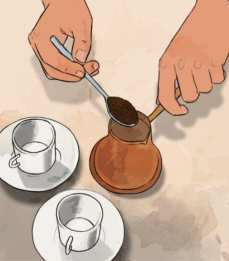Turkish Coffee How to Make?
- Shlomo Krudo
- Jul 21, 2020
- 3 min read
Updated: Oct 26, 2022
Coffee should be black as hell, strong as death, and sweet as love.
Turkish Proverb
Coffee takes the spotlight when one is wandering Turkey. Everywhere you stop, java is on offer, a fixture of daily life.
Turkish Coffee How to Make?
Turkish coffee doesn’t include a long list of additions a la Starbucks, nor is it even filtered.
For Turkey’s traditional coffee style, you grind finely and make it in an ibrik, a small copper pot, slowly heated to infuse the water with maximum flavor.
A beloved drink since the 16th century, Sultan Suleiman the Magnificent, whose staff created the method that continues to be the classic style used today, popularized coffee.
A bold flavor isn’t all that results from making Turkish coffee. The loose grinds leave behind a layer of mud, but unlike tea leaves, the grouts reveal nothing other than how often the drinker rotated the cup to keep the coffee Strong.
Interestingly, although we typically make Turkish coffee on a stove, it’s sometimes made in a pan on a stove full of hot sand in bazaars.
The only difficulty in making Turkish coffee is getting the right blend.
The traditional middle eastern brew has a distinctive taste due primarily to an affinity for Rio-y flavored Brazilian beans, which you usually blend with Ethiopian ones.
You can also use beans, including arabica, which we consider best, but Robusta or a blend would be fine.
Many people believe that Turkish coffee is dark-roasted, but the pulverized coffee is usually a reddish-brown shade, not dark at all.
The Ibrik’s or a cezve is the traditional brewing gear, a small, long-handled copper-or brass plated pan with a narrow neck.
Ibriks come in different sizes and usually have a tiny number underneath, which shows how many cups it holds.
If an Ibrik is unavailable, a small straight-sided saucepan for heating milk will do. However, the coffee may not boil as quickly.
Turkish coffee is the only method that insists on breaking the “never boil coffee” rule, but the coffee boils with sugar.
The bitterness from boiling never affects the flavor. Adding spices such as Cardamom to some coffee varieties in small quantities during the grinding process further enhances the flavor.
Turkish Coffee How to Make?
We grind the beans to a very fine powder that stays at the bottom of your coffee cup when served.
The most important thing about Turkish coffee is foam (froth).
It must have a good foam on top, which is why any ingredients in traditional Turkish coffee you mix before you place on the stove.
Serve a Turkish coffee without proper foam; you can consider it an insult.
Traditionally, you serve Turkish coffee, a small coffee cup, and a saucer with a couple of Delights pieces on the side.
You usually serve a small glass of water with the coffee to cleanse the palate afterward.
How can you make this exotic creation from the comfort of home, then?
How to Make Turkish Coffee?
To make a cup of Turkish coffee, take a heaped spoon of coffee for each cup. For a medium-sweet coffee, add an equal measure of sugar. A sweet-toothed person needs a spoon and a half of sugar.
Once you’ve added the sugar, Measure some water in a Turkish cup and add it to the pot.

Place one heaping teaspoon of coffee for each cup.

Place one very heaped teaspoon of sugar for every cup.
If you add water after adding coffee, it creates a better foam, something you should strive for if you want to replicate traditional Turkish coffee.
Use a teaspoon to stir the coffee, water, and sugar at this stage. You must mix everything thoroughly, put it on low heat, and wait for it to boil. When the mixture threatens to run over the rim of the cezve, quickly remove it from the heat, stir, then return to the heat.
In a moment, it will again boil over; instantly remove the coffee from the heat.
Don’t stir again to keep the foam intact.
Returning the cezve to the third time ensures the flavor’s roundness and thorough blending of coffee and sugar.
You just brewed a perfect cup of Turkish coffee.
When making over one cup of Turkish coffee, you must spoon foam into each cup.
Slowly pour your coffee into the cups. Be careful not to lose that precious foam as you pour.
Traditionally, you eat Turkish delight to add a touch of sweetness. If you add sugar and stir the coffee once it’s poured, you’ll lose the foam.
Were you tempted to try some Turkish coffee? If so, be sure to let us know how you got on.
Turkish coffee is much thicker and more robust than our regular coffee.








Comments